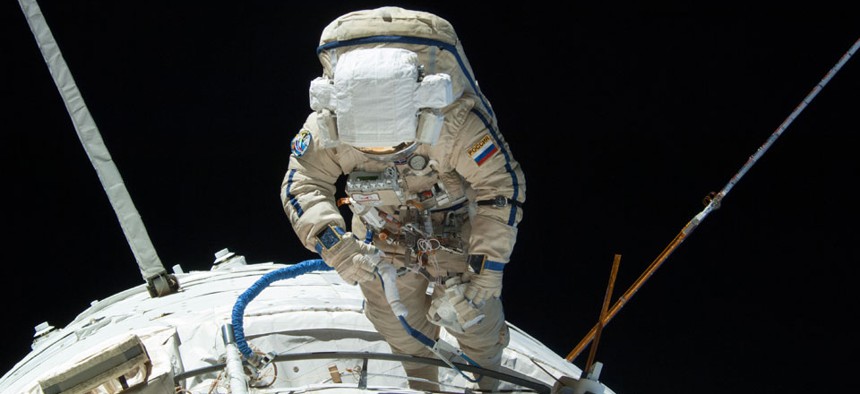At Least Russia and the U.S. Still Get Along in Outer Space
Ukraine crisis is just another blip for collaboration in space exploration.
On Tuesday night, a trio of astronauts launched into space, headed for the International Space Station. Two are Russian, one is American.
Their six-hour shared journey to the orbital laboratory was the near opposite of the one that their home nations are taking here on Earth. As the astronauts got cozy inside a small capsule, ready to live and work together for the next six months aboard the station, the United States and Russia put more and more distance between each other.
President Obama and the other G-8 leaders announced Monday that the organization would forego a planned summertime summit in Sochi and meet without Russian President Vladimir Putin in Brussels as the G-7 instead. The precarious working relationship U.S. and Russia enjoyed before the latter annexed Crimea, a sovereign territory of Ukraine, has certainly deteriorated.
NASA, however, is not worried about the Ukraine crisis taking a toll on space exploration.
"We do not expect the current Russia-Ukraine situation to have an impact on our long-standing civil space cooperation with Russia, which goes back decades, including our partnership on the International Space Station program," said NASA spokesman Joshua Buck in a statement to National Journal. "We are confident that our two space agencies will continue to work closely as they have throughout various ups and downs of the broader U.S.-Russia relationship."
The International Space Station has indeed weathered terrestrial political storms in the past. "It doesn't appear that we are affected by what's going on diplomatically with the Russians," Al Sofge, director of NASA's human exploration and operations division, has said of the conflict in Syria and Russia's protection of American whistle-blower Edward Snowden. "I don't know that we've ever even discussed it."
After 16 years in orbit, the International Space Station is truly a bilateral effort. The station, divided into American and Russian segments, uses American solar arrays and power systems, Russian life-support systems, and a navigation system that comes from both nations.
The U.S. and Russia first collaborated in space in July 1975, when a Soviet Soyuz capsule carrying two cosmonauts docked with a U.S. Apollo module carrying three astronauts. In the 1990s, after the Soviet Union collapsed, the U.S. asked Russia to join its work on the International Space Station. Russia was too financially strapped to build a program of its own, BBC's Melissa Hogenboom explained in 2012, and the U.S. was behind schedule on the project and needed help.
This "reluctant codependency," as NBC space analyst James Oberg dubbed it, persists to this day. At the International Space Station, Russia depends on NASA's electronics and communications technology, which are more advanced. The U.S. depends on Roscosmos, the Russian federal agency, to send its astronauts to space. After NASA retired its space-shuttle program in 2011, Russia became the sole nation with the capability of carrying astronauts and cargo to and from space. Even U.S. national security satellites are powered into orbit on an American rocket with a Russian-built rocket engine.
The partnership is, more or less, a good one. But NASA is eager to break out of Russia's monopoly on astronaut transport, and the current Ukraine crisis, Oberg wrote earlier this month, is a good reason to speed up the effort. Right now, NASA pays $70.7 million per seat to send its astronauts to space on Russian Soyuz capsules, $8 million more than a previous agreement. But by 2017, NASA officials say the U.S. should be able to send its astronauts to the International Space Station on its own, thanks to private American spaceflight companies.
One of those companies could be spacecraft manufacturer SpaceX, a NASA favorite. Its Dragon spacecraft, perched atop a Falcon 9 rocket, will launch for the third time from Cape Canaveral on Sunday, carrying cargo to the International Space Station. Dragon could be modified to carry astronauts as well, but that development is still a few years away.
Until then, the U.S. has other foreign options for sending supplies to the station, including European and Japanese robot freighters. It could also reach out to China, which successfully transported crew to and from a space station last summer. But such a move is highly unlikely for now. China is not one of the 15 participants of the International Space Station project, in part because of U.S. opposition.
The shift away from Russian dependence has bipartisan support in Congress. In 2008, Sen. Bill Nelson, D-Fla., chairman of the Senate's Science and Space Subcommittee, worried that shutting down the space-shuttle program could result in "Russia denying us rides or charging exorbitant amounts for them. The ranking member on that subcommittee, Sen. Ted Cruz, R-Texas, said last spring that the U.S. should use American aerospace contractors to send its astronauts to space.
Recent terrestrial tensions are unlikely to be felt 220 miles into the sky. Earlier this month, NASA chief Charles Bolden said some have wondered whether the International Space Station, which has "continued to exist and continued to function with people from a variety of cultures and beliefs," should be nominated for a Nobel Peace Prize. Considering the station may now be one of the few places where U.S.-Russia relations are going well, that might not be such a bad idea.




